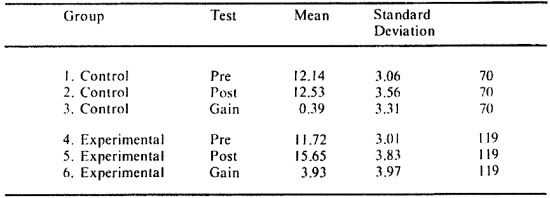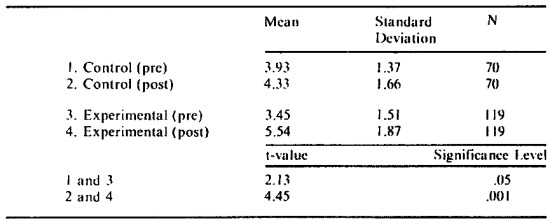The purpose of study reported in this article
was to determine whether students gained more understanding of
scientific principles when taught from a two-model approach to
origins (evolution and creation) than when taught evolution only.
That is, from the standpoint of good science education and good
instructional practices, is this a better approach than teaching
evolution only?
In the last twenty years a significant number
of scientists have become disenchanted with the evolutionary model
as an explanation for the origin and development of all things.
Many such scientists now are convinced that creation is the better
model. "The creation model postulates that all the basic
systems of nature, including elements, stars, planets, life, and
the major kinds of organisms, including man, were created fully
developed, by supernatural creative processes.…" (Morris,
1975, p. 9). Special groups of scientists, the Creation Research
Society and the Institute for Creation Research, in particular,
have been formed to search for new data and re-evaluate old data
from a point of view that would include this model.
In contrast to the creation model, the evolution
model explains the origin and development of all things by natural
laws and processes that are in operation at this time. Evolutionists,
as strictly defined, reject the concept of a world view based
upon special creation by a supernatural Creator. In the main,
evolutionists reject creationism on the basis that it is a religion,
maintaining that evolution is the only scientific theory. Creationist
scientist, however, have emphasized the lack of evidence supporting
the evolution model and the preponderance of scientific evidence
supporting that of creation.
This question, therefore, has not yet been resolved
in the minds of scientists. In the year 1975 alone over 60 college
and university campuses, not to mention numerous public schools,
hosted creation lectures and creation/evolution debates. In addition
to this, special seminars, workshops and Summer Institutes are
constantly being held to teach and research the scientific data
supporting both the evolution and creation models. Hundreds of
teachers have taken advantage of these institutes and many are
questioning past classroom practices in this regard.
The purpose of this paper, however, is not to
compare the two models scientifically, but rather to examine the
pedagogical reasons for teaching them. In the first place, many
public opinion polls have shown that parents and citizens in general
overwhelmingly desire both models to be taught in the public schools,
rather than the present practice of teaching only evolution. For
example, in 1973, in Del Norte County Unified District (California)
the following data were compiled in a random survey of 1,346 homes:
"Should evolution be taught in the public schools?"
58% yes 34% no 8% undecided
"Should creation be taught in the public
schools?" 89% yes 8% no 3% undecided
In Cupertino Union School District (California)
these data were compiled in a statistically-sound random survey
of 1,995 homes:
be presented along with evolution?" 84.3% yes 7.8% no
6.3% uncertain 1.6% neither
A continuing random telephone survey is being
conducted in many cities by the Institute for Creation Research
Midwest Center. The central question in this survey is:
"Should evolution only, creation
only, both evolution and creation or neither evolution or creation
be taught in the public schools?"
Results compiled to date yield the following
data:
both evolution and creation or neither evolution or creation be
taught in the public schools?" 5.2% evolution only 18.9%
creation only 64% creation and evolution 11% neither evolution
or creation
While these data are limited, they nevertheless
provide a good sampling of what adults feel is fair and proper
for public schools.
Legal support for teaching creation as an alternative
nonsectarian model is very clear. A thorough research of this
issue was given in the January, 1978 issue of the Yale
Law Journal. The subject was treated in the law review note
on "Freedom of Religion and Science Instruction in Public
Schools." (Bird, 1978)
"Neutralization by means of instruction in scientific
creationism also would not necessarily have a legislative purpose
of furthering religious rather than secular concerns that would
contravene the establishment clause ... Similarly, addition of
scientific creationism to a biology course that exclusively teaches
the general theory has the secular legislative purpose of presenting
more than one nonreligious explanation of the origin of the world
and life. Even Clarence Darrow of the Scopes Trial fame remarked
that it is ‘bigotry for public schools to teach only one
theory of origins’."
This particular study was undertaken to determine
the statistical relationships between students studying the origin
of living things when they had two models to choose from—creation
and evolution—as opposed to students who studied evolution
only. The study was designed to study whether there were any statistical
differences in effectiveness between the two methods of teaching
among students in high school biology classes. The research design
chosen for this study is known among educators as the "Pre-test,
Post-test, Control Group" design. Internal control was maintained
over the processes of data collection through computer assigned
classes (random program), and all teachers involved in the experimental
classes had been thoroughly instructed in how to use a two-model
approach to the question of origins. They were equally divided
in personal preference between evolution and creation. The subject
matter guidelines were derived from Origins: Two Models, Evolution/Creation
by R. Bliss. The control group was taught the normal traditional
material from the basic text, Biology: Living Systems by
Oram, Hummer and Smoot. The instructor for the control group did
not receive training in a two-model approach but had many hours
of study in BSCS biology and inquiry techniques.
The pre-test (test prior to the course) and
post-test (test after the course) consisted of a criterion-referenced
test involving concepts and mechanisms related to origins of life,
as well as a so-called Likert preference scale showing student
preference before instruction and again after instruction.
The initial data from this study consisted entirely
of the responses of students to the pre- and post-criterion referenced
test and the pre- and post-Likert performance type inventory.
In addition to this, many other parameters were separated for
scrutiny such as high IQ, low IQ, medium IQ, etc.
It was important to this study to note that
there was no significant difference between the two groups on
the criterion pre-test and the Likert preference. Thus both groups
had basically the same beginning level. On the post-test, it was
clear that a significant gain was made by the experimental (two-model)
approach group. In fact, the experimental group gain was at the
.001 level and this is very significant. Tables I and II summarize
the statistical measures that were used to determine the effectiveness
of learning achieved under the two methods.
TABLE I
Experimental and Control Group Achievement Means

TABLE II
A Comparison of Experimental and Control Group Achievement Means

A very interesting development showed up when
the sub-test scores on evolution items came in. The statistical
t-value showed that those in the experimental group (those studying
both models) did better in learning even the evolutionary data
and arguments than did the students studying evolution only. This
was unexpected. See Table III. Of course, those in the experimental
group also did better on
TABLE III
Results of Sub-test Scores on Evolution Model Items

creation sub-test items than did those that studied
evolution only. This of course, was expected. The data from the
Likert scale showed that those students in the experimental group
in the middle and high IQ range showed a significant increase
in preference toward the creation model after they had examined
all of the data. In other words, they became more creationistic
in their point of view and less evolutionary.
In conclusion, this study shows that students
seem to be more highly motivated and to learn more effectively
when studying science from a two-model approach. They seem to
have a better grasp of the data surrounding origins and they seem
to be open minded and willing to change their views when new data
arrive. The experimental group seemed to develop more critical
thinking habits than those who studied origins from an evolutionary
model only. It would seem, then, that it would be unconscionable
from a pedagogical and scientific point of view, to teach only
evolution to students in the public high schools. It is therefore
recommended, from the standpoint both of good science and good
instructional practice, that every public school should teach
origins from a two-model approach.
Bibliography
Bird, Wendell, "Freedom of Religion and
Science Instruction in Public Schools," Yale Law Journal,
Vol. 87, No. 3, pp. 515-570, Jan., 1978.Bliss, Richard B., "Origins: A Two-Model
Approach—A Curriculum Imperative," speech to: (Evolution
Section) American Institute of Biological Science, Detroit,
1970. (Available from Institute for Creation Research, 2716
Madison Avenue, San Diego, CA 92116).Bliss, Richard B., Origins: Two Models—Evolution
and Creation, Institute for Creation Research, Creation-Life
Publishers, San Diego, CA, 1976.Cupertino Union School District, Del Norte
County Unified School District, by Louis Goodgame, for State
Board of Education, State of California, 1976.Institute for Creation Research Midwest Center,
(Box 75, Wheaton, Ill., 60187) Fourteen- State Survey, 1976-78.Morris, Henry M., "Scientific Creationism,"
Creation Life Publishers, San Diego, CA, 1975.Troost, John C., "An Analysis of Factors
Influencing the Teaching of Evolution in the Secondary Schools
of Indiana," Doctoral Dissertation, Indiana University,
1966.
* Former Director of Science Education, Unified
School District #1, Racine, Wisconsin. Former Director of ICR's
Curriculum Development



